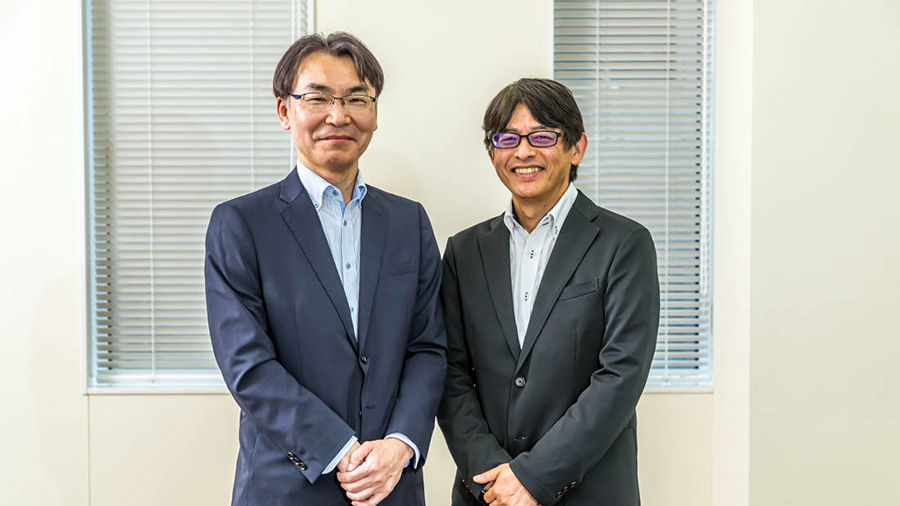New Working Methods and Value Creation, Enabled by DX
Hitachi Construction Machinery is using RPA “robots”, which process routine tasks on PCs, and Microsoft’s Office 365 business software, to promote operational transformation, raising efficiency and productivity and realizing new ways of working.
We examined these two actions which have been key to DX for internal operations.

If repetitive tasks that are performed by humans can be automated, the working time expended on routine work can be cut, and the time that is freed up can be reassigned to work that only humans can do.
Tanigawa says “The Office Transformation Group in the DX Promotion Group tries out digital tools to the full for changing operation processes and creating an easier working environment.
It then introduces the good tools within the company and promotes their use”.
Conventionally, it would have been the norm to ask the IT Division to develop systems and applications for automating routine tasks, but the Office Transformation Group is promoting a change of approach, to one in which the employees of each department take the lead in development.
Actions using RPA began in the second half of 2018.
RPA software was introduced that allows people to develop robots even if they have no expert knowledge or skills.
Our first step was to spend half a year asking the whole company what kinds of operations should be replaced by RPA.
Tanigawa reveals that “at first we didn’t get a lot of answers”.
Then, in 2019, they made a companywide search to identify routine operations.
The search found around 4,000 routine operations, equivalent to around 24,000 hours of work.
That triggered a rapid acceleration of action, and now every department is developing robots tailored to its own operations, to advance its improvements.
“Such operations were particularly numerous in the Production and Procurement Headquarters, and by March 2022 we’d developed 104 robots that had saved 1,279 hours in improvements.
That was amazing progress in RPA use” (Tanigawa).
The introduction of Microsoft’s Office 365 business software began in 2018.
To make effective use of the various tools included in Office 365, they first thought of using Microsoft Teams, which enables chat and video conferencing within teams, to improve work efficiency.
“Our starting point was that meetings we don’t need to meet up for should be completed without meeting.
But people didn’t really understand what was different from email, and the number of users didn’t increase, so it was ineffectual at first”, says Kudo, looking back.
But after that, Microsoft Teams sank in, partly because of the Covid pandemic, and people started using other functions too, like task management.
In the last two years or so, they have been working to promote the use of Power Platform, and that makes it easy for people to make their own apps, which help with operation improvements in their departments.
Apparently in-house app creation has begun in some departments.
The RPA Award for in-house work promotes usage
The RPA Award is given to recognize outstanding RPA work, and work on developing robots to match each department’s needs is steadily getting traction.
But Kudo says in-house creation of business apps is “still only halfway there”.
“Particularly in administrative departments, there are hurdles to overcome even if the interest is there, so we’re just ready for questions people ask us.
Therefore, we’re sending the message that people should feel free to consult us, even if it’s just at the level of ‘I think I’d like to do something like this’”.
The examples of apps made with Power Platform present simple apps, like a temperature measurement app allowing one-click submissions and approvals (see p.09), rather than more advanced apps.
The purpose of operational transformation by digital means is to achieve reforms in how employees work, not just to improve productivity.
“Thinking of how to get closer to clients and creating time for action leads ultimately to solutions to the client’s challenges” (Tanigawa).
“If efficiency improves in internal operations, we can achieve shorter response times, better precision, and lower costs, and we can contribute the results to the clients” (Kudo).
Following that approach, the Office Transformation Group will promote work on DX for internal operations, towards participation by all employees in future.
* Microsoft Teams, Office365, Excel, Outlook, and Power Platform are registered trademarks or trademarks of Microsoft Corporation in the United States and other countries.
The key to success is shifting to internal production
Examples of in-house DX action
At Hitachi Construction Machinery, the employees develop their own automated robots and applications and improve their operations.
These are just a few examples.
Automating 28 hours a week of indirect operations with RPA

Power and Information Control Platforms Division
Device Production Engineering Department
IoT Promotion Group
Jun Sato
RPA was introduced to automate routinely occurring indirect operations in production and manufacturing.
It automates the work of tallying expenses used in manufacturing and comparing against the current amount of work, to check where expense usage is appropriate, and informing the people concerned of the delivery status of the goods which generated the expenses.
Before RPA was introduced, the work of gathering, tallying, and reporting data was done manually, consuming large amounts of human resources.
One example of effects after deployment is that RPA for expense management can now automate 1,680 minutes/month of indirect operations.
RPA replaced the work, allowing more time to be assigned to tasks which require human decision making.
This project also raised my skills for the development of macros used in the development.
We expect RPA to evolve into a more accessible form in future, so we urge everyone to try it.
Reducing the time for routine operations

Parts and Service BU Customer Support Division
CS Planning Department
Performance and Process Management Group
Gaun Min
I’m in charge of operations related to tallying and analyzing daily sales in each Group company in parts and service, preparing budgets, and so on.
I used RPA to automate the work of gathering daily parts and service business performance from each company’s core systems, visualizing it, and distributing the data.
Before, no unified core systems had been introduced across each Group company, so it wasn’t possible to gather each day’s data as a batch process.
Even after we got the data, it took a lot of work for updating and correcting the data.
Introducing RPA made it possible to keep track of performance on a daily basis, when that was previously done on a weekly or even monthly basis.
I also built a system that distributed alarms via email if there were abnormal values, like unlinked data, enabling rapid responses.
Using RPA saved a lot of time, leaving me free to analyze the data and think of ways to use it.
Thinking “Is this waste?” is a kaizen opportunity

DX Promotion Group
DX Transformation Division
DX Operational Transformation Department
Emi Miyakawa
The spread of Covid-19 made it essential for Hitachi Construction Machinery to report employees’ temperature records at the start of each day to superiors.
At the start of the pandemic that was done in Excel, with submissions and approvals handled via email.
Wanting to cut even a little of that workload, I used Power Platform to develop and app so that we could report to superiors with one click, and they could check and approve the content with one click.
I added fields for entering work locations and other report info besides temperature readings to send to superiors, to facilitate communication.
I expected app development to be difficult, but I had support from the DX Promotion Group, so I could create the app even though I had no programming experience, which also improved my skills.
“This job is such a hassle…” “Is this is waste?” When you think something like that, it’s a kaizen opportunity.
I think the accumulation of little kaizen improvements can raise productivity.
Using DX to achieve “small but convenient” things!

Human Resources Division
General Affairs Division Secretarial Group
Hiroko Akimaru
In my secretarial work, I’m in charge of managing the schedules of company directors and coordinating the related arrangements.
It used to take me a lot of work to register each individual meeting or event etc. to be attended by a director into Outlook schedule.
So, I built in a system for automatically registering the directors’ meetings for a whole year into Outlook in one batch.
Other than that, I introduced systems for automatically keep track of congratulation and condolence information posted in online newspapers, to partially automate updating directors’ information, and a few other tools to make previous operations a little easier.
This development work increased my knowledge of RPA, macros, and so on.
Another big benefit was that I was able to communicate more smoothly than ever before with the people in the DX Promotion Group.
When they hear “DX”, many people think of innovative systems and high hurdles, but I think achieving “small but convenient” things that we can introduce in our own departments is the best part of DX.

